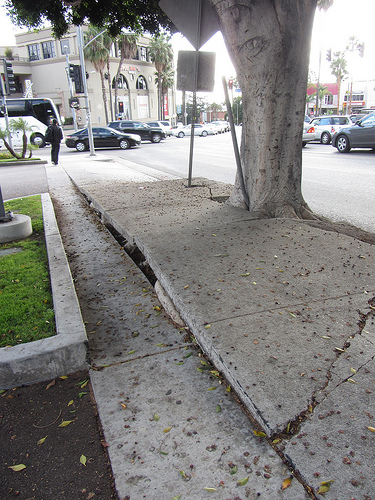Last week, the L.A. City Council approved criteria for prioritization of its $1.4 billion 30-year sidewalk repair program. The program is the result of the Willits lawsuit for wheelchair user access. When sidewalk repair prioritization was before the city council Budget and Finance Committee last December, Councilmember Paul Koretz removed proposed Vision Zero language. Last week, the full council undid Koretz' modification, reinstating Vision Zero High Injury Network criteria. The council further added sidewalk repair prioritization for first/last mile connections to Metro.
Most Angelenos know that there is a huge backlog of broken sidewalks to repair. The city's Bureau of Engineering set up a website for wheelchair users and the general public to request sidewalk repairs. The BOE proposed a prioritization scoring system that included land usage type, incidents reported, severity of damage, cost effectiveness to repair, and whether the site was on or near the Vision Zero High Injury Network (HIN). The HIN is the six percent of L.A. streets where 65 percent of traffic deaths/severe injuries take place.
While sidewalk repair will not solve all the safety issues on the HIN, the HIN does serve as a proxy for places where plenty of people actually walk and roll. Investing in Place, a key non-profit leading a coalition effort to make sidewalk repair effective in improving equity and mobility, submitted a comment letter urging the city to include HIN prioritization criteria. Investing in Place organized nearly 40 organizations and individuals to push for effective repair prioritization. The coalition comment letter states:
[The High Injury Network] prioritizes vulnerable road users through its weighted focus on children and older adults. Efforts to improve sidewalk conditions are both a) efficient and effective in improving conditions where highest rates of people are traveling on sidewalks, and b) addressing a complementary need to the Vision Zero effort of reducing injuries and fatalities.
For the sidewalk repair program (council file 14-0163-S3), the full council approved a prioritization motion by Councilmember Paul Krekorian. The Krekorian prioritization matrix restored the BOE's original HIN prioritization criteria, while also adding points for Metro's First/Last Mile Network and for residential streets.
Responding to last week's council vote, Investing in Place's Naomi Iwasaki wrote:
Reinstating the HIN back into the city's new sidewalk repair program prioritization criteria may not have happened without the overwhelming push we saw from our community organizations and partners who wrote into City Council to support the connection between transportation safety and infrastructure repairs. Big picture, this also has opened up conversations for how the City of L.A. might better coordinate between mobility and infrastructure issues. For most people in LA, departmental jurisdiction is not important. We just want safe sidewalks and streets for walking and rolling.







